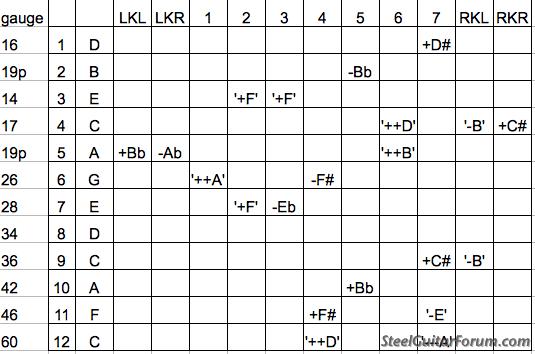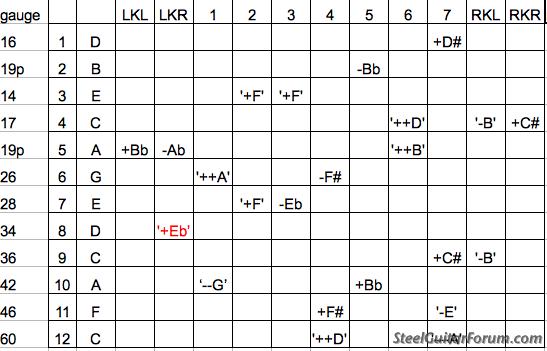| Author |
Topic: my UniC6 copedent |
Jan Oelbrandt
From:
Herzele, Belgium
|
 Posted 27 Sep 2016 6:09 am
Posted 27 Sep 2016 6:09 am |
|
As requested, here's my universal C6 tuning I came up with.
It's based on a 12-str C6 copedent I found on this site (but not anymore... Don't know where're it's gone) by Buddy Emmons. After setting up my guitar that way, I further enhanced the copedent to suit my needs, and to make it - I am convinced - truly universal.
So here's the copedent:

to make it clear, I made a spreadsheet comparing the string relations of a standard E9th and C6th 10-string.
As you can see, all string relations are present in the uniC6 (* see note below)

Conclusion: If I omit strings 5 & 12, I have the E9th (but 2 whole tones lower sounding). If I omit strings 2 & 8 I have a complete C6th.
And what about pedals and knee levers?
"E9": I have pedals A & B, I raise and lower the root on the Right Knee
"C6": I have pedals 5, 7 & 8 exactly the same (but on 4, 6 & 7 because my MSA only has 7 pedals), and pedal 6 is there but moved to pedal 3.
* Except for the two lowest of E9th (D and B) |
|
|
 |
Jeff Harbour
From:
Western Ohio, USA
|
 Posted 28 Sep 2016 4:28 pm
Posted 28 Sep 2016 4:28 pm |
|
Very interesting... Quite an efficient copedant for a 7+4 setup. I like the idea for the 'all-inclusive' universal tuning (like yours, Beck's, or Tharpe's) as opposed to the E9/B6 concept.
Is this the copedant of Buddy's that you're referring? :
http://www.buddyemmons.com/info.htm#C12 |
|
|
 |
b0b
From:
Cloverdale, CA, USA
|
 Posted 28 Sep 2016 8:52 pm
Posted 28 Sep 2016 8:52 pm |
|
I've been going in a similar direction (on my D6th). One thing I've discovered with the RKL change: you don't really need to lower the middle C because it's a really easy bar slant. There are many C6th chord positions that rely on keeping the middle C while lowering the high C to B. Unless you are totally allergic to slants, I recommend just lowering the high C on RKL.
Another suggestion: swap your pedals 3 and 5. The standard C6th order of pedals gives you those bouncy E9th C pedal "Mooney" licks on C6th pedals 6 & 7 (your current 3 & 6). Those pedals need to be next to each other for that to work. There are other reasons, too.
Every time I've messed with the ordering of C6th pedals, it's been a mistake. I know it seems strange  at first, but I've come to the conclusion that it's perfectly brilliant. at first, but I've come to the conclusion that it's perfectly brilliant. 
_________________
-𝕓𝕆𝕓- (admin) - Robert P. Lee - Recordings - Breathe - D6th - Video |
|
|
 |
Ian Rae
From:
Redditch, England
|
 Posted 29 Sep 2016 1:22 am
Posted 29 Sep 2016 1:22 am |
|
| b0b wrote: |
| Every time I've messed with the ordering of C6th pedals, it's been a mistake. I know it seems strange at first, but I've come to the conclusion that it's perfectly brilliant. |
From my reading of history I get the impression that it was arrived at in some haste - that the E9 side of the Sho-bud was ready to roll but Buddy needed to come up with something quick for the C6 and that it was pretty much scrawled on a napkin. (It would have been in the great man's mind already, we assume.)
It's interesting that in the the written introduction to his Basic C6 course B.E. explains the C6 changes in terms of the E9, not the B6 with Es lowered, so that's clearly how he thought of it.
_________________
Make sleeping dogs tell the truth!
Homebuilt keyless U12 7x5, Excel keyless U12 8x8, Williams keyless U12 7x8, Telonics rack and 15" cabs |
|
|
 |
Jan Oelbrandt
From:
Herzele, Belgium
|
 Posted 29 Sep 2016 6:27 am
Posted 29 Sep 2016 6:27 am |
|
Yes it is! |
|
|
 |
Jan Oelbrandt
From:
Herzele, Belgium
|
 Posted 29 Sep 2016 6:34 am
Posted 29 Sep 2016 6:34 am |
|
| b0b wrote: |
Another suggestion: swap your pedals 3 and 5. The standard C6th order of pedals gives you those bouncy E9th C pedal "Mooney" licks on C6th pedals 6 & 7 (your current 3 & 6). Those pedals need to be next to each other for that to work. There are other reasons, too.
|
Well, at first they were next to each other (position 5&6 on my 7-pedal guitar).
But in the music I play, I often need to raise my major third to the sus4 and lower it to a minor third. That's the main reason I've put the E->Eb next to the E->F. And I also do a lot of the pedal 6-7 combination you speak of, but now using both foots. I really don't care much about my volume pedal, so it's no problem for me to lift my right foot to reach the pedals. |
|
|
 |
b0b
From:
Cloverdale, CA, USA
|
 Posted 29 Sep 2016 7:31 am
Posted 29 Sep 2016 7:31 am |
|
If you're 2-footing it, then it makes sense.
On C6th, P5 and P6 are the "home" position. I'd get really confused if they were reversed, like playing Day pedals after a lifetime on Emmons. Do you get confused when you sit down at a standard C6th?
_________________
-𝕓𝕆𝕓- (admin) - Robert P. Lee - Recordings - Breathe - D6th - Video |
|
|
 |
Tom Gorr
From:
Three Hills, Alberta
|
 Posted 30 Sep 2016 5:56 am
Posted 30 Sep 2016 5:56 am |
|
Jan, I had been thinking about going in a similar direction with my open string tuning, probsbly with b0bs lead in using D as the root... but am at the point where I am worried about having yet one more variation on pedal steel copedant in the house.
The most compelling attribute is the string sequence 123568 by scale degree. That is a pentatonic scale of course. .. the backbone of pop music in all its variations... the black keys on the piano etc. It ought to be the correct starting point regardless of the historical weight of E9 or C6 open tuning.
b0b, on my 5x5 E9/B6 12 string uni. My pedal order is A B P6 P5 P8 . P4 and P7 split function on knees...
. I don't think there is a better order for singlefoot playing. (Lol.. ymmv)
My 8x8 D10 has the regular Shobud type setup.. A thru P8 I double foot the C6 side... P5/P6 and P7/P8... overall I prefer this arrangement within the context of a full blown C6 coped but don't like the E9 side as much as my Uni 5x5 coped.
i don't get mixed up because I play different songs on each of my steels.. haha.
I will say that my biggest issue with copeds is I cannot get along with an Emmons coped with Es on the left knee to save my life. The split knee Es are fundamental to my playing style. |
|
|
 |
Jan Oelbrandt
From:
Herzele, Belgium
|
 Posted 2 Oct 2016 12:25 am
Posted 2 Oct 2016 12:25 am |
|
| b0b wrote: |
| Do you get confused when you sit down at a standard C6th? |
No, I have a D-10 with standard C6 pedal positions. I often don't play it for 3 months in a row, but when I take it out it doesn't take me longer then 2 minutes to play anything I want on it. The spring spacing is a tougher issue then the position of the pedals (a lot narrower on the 12-string) |
|
|
 |
Jan Oelbrandt
From:
Herzele, Belgium
|
 Posted 2 Oct 2016 12:31 am
Posted 2 Oct 2016 12:31 am |
|
| Tom Gorr wrote: |
| but am at the point where I am worried about having yet one more variation on pedal steel copedant in the house. |
If you switch back and forth between guitars often enough, you'll have no problem. I play almost a dozen different tunings (Weissenborn, dobro, lapsteels, pedal steels,... all different!) so I know what I'm talking about. The best exercise: pick a song and let it play in a loop. Each time it restarts, do it with an other guitar (tuning)
| Tom Gorr wrote: |
| The most compelling attribute is the string sequence 123568 by scale degree. |
I agree. And as I said: if you omit the 6the degree, you have the sequence of E9th, if you omit the 2nd degree, you have the C6th. Takes so getting used to, but it works for me... To be noted: I use my thumb + 3 fingers... so skipping strings is, I guess, easier for me then for others |
|
|
 |
Jan Oelbrandt
From:
Herzele, Belgium
|
 Posted 2 Feb 2018 11:30 am
Posted 2 Feb 2018 11:30 am |
|
in the meantime,
I added a 10th string lowering A to G.

the one in red on string 8 is what I want to add next...
_________________
MSA U12 (uni C6), '71 &'73 Emmons PP, Fender '56 Champion lap steel, custom build Weissenborn. Johnson, Mattelin & '31 Regal resonators, MusicMan RD65 or Quilter head through a 12" Jensen (psg), MusicMan 65 amp (lap). Daddy Slide tonebar |
|
|
 |
b0b
From:
Cloverdale, CA, USA
|
 Posted 2 Feb 2018 12:46 pm
Posted 2 Feb 2018 12:46 pm |
|
When I was playing 12-string C6th, I lowered the middle D string (8) to C# on the lever that raises high C (4) to C#. I used that a lot.
_________________
-𝕓𝕆𝕓- (admin) - Robert P. Lee - Recordings - Breathe - D6th - Video
Last edited by b0b on 3 Feb 2018 9:11 am; edited 1 time in total |
|
|
 |
Bill C. Buntin
|
 Posted 3 Feb 2018 7:30 am
Posted 3 Feb 2018 7:30 am |
|
| That is cool. I have thought about different versions of this at different times, along the same lines as the Anderson Bb6. I've just never jumped from D10 to a 12 string and tried it. I would like to try this tuning and I would like to give the Bb6 universal an honest try. And maybe develop into one such tuning to be so comfortable with that will last a lifetime. Thanks for posting. |
|
|
 |




